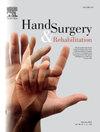Clinical and psychosocial characteristics of persistent finger post-traumatic segmentary exclusion syndrome: A descriptive study
IF 0.9
4区 医学
Q4 ORTHOPEDICS
引用次数: 0
Abstract
Purpose
Segmentary exclusion syndrome is a motor behavior disorder characterized by non-use or underuse of a limb segment, typically following local inflammation after trauma. Despite its significant impact on hand function and quality of life, segmentary exclusion syndrome is underrecognized and often diagnosed late. This study describes the population, and the symptoms associated with persistent finger segmentary exclusion syndrome.
Materials and methods
A retrospective analysis was conducted in a specialized hand surgery center. Twenty-one adult patients diagnosed with segmentary exclusion syndrome persisting >3 mo post-trauma were included. Data collected included demographics, injury mechanisms, somatosensory disorders, flexion active range of motion, pain during movement, psychosocial flags, and sleep disturbances.
Results
Somatosensory disorders were present in 81% of patients, with allodynia (76%) and hyperesthesia (18%) as the most common subtypes. Flexion active range of motion limitations were observed in 52% of patients, often co-occurring with sensory disturbances or pain. Pain was reported in 29% of patients but was rarely an isolated symptom. Psychosocial factors were prevalent, with yellow flags in 71%, black flags in 62%, and blue flags in 29%. Sleep disturbances were reported in 52% of cases.
Discussion
Persistent finger segmentary exclusion syndrome is primarily associated with somatosensory disturbances, particularly allodynia and hyperesthesia, which appear central to its chronicization. Psychosocial factors and sleep disturbances were highly prevalent. Early recognition and a holistic, multidisciplinary approach seem therefore essential to improve outcomes in affected patients.
Level of evidence
IV.
持续性手指创伤后节段排斥综合征的临床和社会心理特征:一项描述性研究。
目的:节段排斥综合征是一种运动行为障碍,其特征是肢体节段不使用或未充分使用,通常在创伤后局部炎症后发生。尽管对手功能和生活质量有重大影响,但节段性排斥综合征未被充分认识,而且往往诊断较晚。本研究描述了人群和与持续性手指节段排斥综合征相关的症状。材料与方法:回顾性分析某专业手外科中心的病例。本研究包括21例创伤后3个月诊断为节段排斥综合征的成人患者。收集的数据包括人口统计学、损伤机制、体感障碍、屈曲活动范围、运动时疼痛、社会心理信号和睡眠障碍。结果:81%的患者存在躯体感觉障碍,其中异常性疼痛(76%)和感觉亢进(18%)是最常见的亚型。52%的患者出现屈曲活动范围受限,常伴有感觉障碍或疼痛。29%的患者报告有疼痛,但很少是孤立的症状。心理社会因素普遍存在,黄旗占71%,黑旗占62%,蓝旗占29%。52%的病例报告有睡眠障碍。讨论:持续性手指节段排斥综合征主要与躯体感觉障碍有关,特别是异常性疼痛和感觉亢进,这是其慢性化的核心。心理社会因素和睡眠障碍非常普遍。因此,早期识别和全面的多学科方法似乎对改善受影响患者的预后至关重要。证据等级:四级。
本文章由计算机程序翻译,如有差异,请以英文原文为准。
求助全文
约1分钟内获得全文
求助全文
来源期刊

Hand Surgery & Rehabilitation
Medicine-Surgery
CiteScore
1.70
自引率
27.30%
发文量
0
审稿时长
49 days
期刊介绍:
As the official publication of the French, Belgian and Swiss Societies for Surgery of the Hand, as well as of the French Society of Rehabilitation of the Hand & Upper Limb, ''Hand Surgery and Rehabilitation'' - formerly named "Chirurgie de la Main" - publishes original articles, literature reviews, technical notes, and clinical cases. It is indexed in the main international databases (including Medline). Initially a platform for French-speaking hand surgeons, the journal will now publish its articles in English to disseminate its author''s scientific findings more widely. The journal also includes a biannual supplement in French, the monograph of the French Society for Surgery of the Hand, where comprehensive reviews in the fields of hand, peripheral nerve and upper limb surgery are presented.
Organe officiel de la Société française de chirurgie de la main, de la Société française de Rééducation de la main (SFRM-GEMMSOR), de la Société suisse de chirurgie de la main et du Belgian Hand Group, indexée dans les grandes bases de données internationales (Medline, Embase, Pascal, Scopus), Hand Surgery and Rehabilitation - anciennement titrée Chirurgie de la main - publie des articles originaux, des revues de la littérature, des notes techniques, des cas clinique. Initialement plateforme d''expression francophone de la spécialité, la revue s''oriente désormais vers l''anglais pour devenir une référence scientifique et de formation de la spécialité en France et en Europe. Avec 6 publications en anglais par an, la revue comprend également un supplément biannuel, la monographie du GEM, où sont présentées en français, des mises au point complètes dans les domaines de la chirurgie de la main, des nerfs périphériques et du membre supérieur.
 求助内容:
求助内容: 应助结果提醒方式:
应助结果提醒方式:


